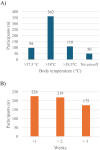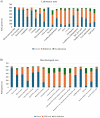Fever management in children and insights into fever of unknown origin: a survey among Italian pediatricians
- PMID: 39554308
- PMCID: PMC11563795
- DOI: 10.3389/fped.2024.1452226
Fever management in children and insights into fever of unknown origin: a survey among Italian pediatricians
Abstract
Background: Fever is a common symptom in children, but despite existing guidelines, pediatricians may not fully apply recommendations. Fever of Unknown Origin (FUO) is generally referred to as an unexplained prolonged fever. However, a standardized FUO definition and management is missing.
Objective: To collect updated data on the approach to fever and FUO among Italian pediatricians.
Methods: A cross-sectional anonymous survey was conducted among a large sample of primary care and hospital pediatricians. The panel group formulated and proposed a practical FUO definition, using a modified Delphi approach. A 75% consensus was required to reach an agreement.
Results: Among 620 respondents, paracetamol was the first-choice antipyretic for 97.7% of participants, followed by ibuprofen; 38.4% prescribed antipyretics based on a specific body temperature rather than on child's discomfort, while physical methods were almost completely abandoned. Alternate treatment was recommended by 19.8% (123/620) of participants, 16.9% (105/620) would prescribe antipyretics to prevent adverse events following immunization. Regarding FUO diagnosis, 58.3% (362/620) considered as cut-off a body temperature above 38°C; the duration required was one week according to 36.45% (226/620) of participants, two weeks according to 35.32% (219/620). The FUO definition proposed by the expert panel reached 81% of consent. Large agreement was observed on first-level laboratory and instrumental investigations in the diagnostic evaluation of FUO, whereas more discrepancies arose on second and third-level investigations. Compared to what participants reported for the treatment of non-prolonged fever, a significant decrease in the prescription of paracetamol as first-choice drug in children with FUO was observed (80.5%; P < 0.0001). Interestingly, 39% of participants would empirically recommend antibiotics, 13.7% steroids, and 4.5% Nonsteroidal Anti-Inflammatory Drugs (NSAIDs) for persistent FUO.
Conclusion: Non-recommended behaviors in fever management persist among pediatricians, including alternating use of paracetamol and ibuprofen, and their prophylactic use for vaccinations. Our data confirm the variability in the definition, work-up, and management of FUO. We observed that in children with FUO paracetamol was significantly less commonly preferred than in non-prolonged fever, which is not supported by evidence. Our findings combined with evidence from existing literature underlined the need for future consensus documents.
Keywords: children; fever; fever of unknown origin; ibuprofen; paracetamol.
© 2024 Chiappini, Orlandi, Chiarugi, Di Mauro, Insalaco, Milani, Vallini and Lo Vecchio.
Conflict of interest statement
The authors declare that the research was conducted in the absence of any commercial or financial relationships that could be construed as a potential conflict of interest. The author(s) declared that they were an editorial board member of Frontiers, at the time of submission. This had no impact on the peer review process and the final decision.
Figures







